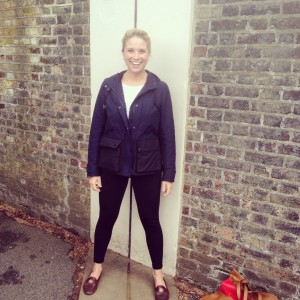It goes without question that America’s entry into and contribution to World War II led to the Allied victory. However,  I’ve come to see that victory in an entirely different light from London, England.
I’ve come to see that victory in an entirely different light from London, England.
Arriving in London five days ago, Hannah Parks and I walked the streets of Westminster as we waited for our colleagues to
arrive. As we looked around, we quickly came to find that the remembrance of the men and women who waged WWII surrounds the urban hustle and bustle of the city. Juxtaposed to clothing stores, food markets, and pubs are statues, museums, and memorials of the collective effort to defeat the Führer. As we walked from Charring Cross to Westminster Abbey, we saw statues to Bernard Montgomery and William Slim and a memorial to French women in the Resistance. Without question, London is a monumental city.
 Our group convened Thursday morning and started our educational journey at the Churchill War Rooms. I found this interesting because my knowledge of WWII to this point has been mostly focused on FDR, Truman, and Eisenhower as leaders and heroes. Yet, being able to see where Churchill and his staff essentially lived during the Blitz and up until 1945 really was eye opening. From the concrete slabs to the sirens, it was evident that the pressing threat of invasion dictated the structure, organization, and flow of everyday life in the war rooms. Additionally, we saw the childhood of Churchill and his life leading up to his involvement in the Allied war effort. The details of his life and the details of the war laid the foundation of the museum. Yet what I found to be the most stimulating was that the rooms were shut down and sealed in 1945 after the war. As the war ended, Churchill and his cabinet shut off the lights and left the building to go home, without looking back. It wasn’t until the 1970s that they were reopened and explored.
Our group convened Thursday morning and started our educational journey at the Churchill War Rooms. I found this interesting because my knowledge of WWII to this point has been mostly focused on FDR, Truman, and Eisenhower as leaders and heroes. Yet, being able to see where Churchill and his staff essentially lived during the Blitz and up until 1945 really was eye opening. From the concrete slabs to the sirens, it was evident that the pressing threat of invasion dictated the structure, organization, and flow of everyday life in the war rooms. Additionally, we saw the childhood of Churchill and his life leading up to his involvement in the Allied war effort. The details of his life and the details of the war laid the foundation of the museum. Yet what I found to be the most stimulating was that the rooms were shut down and sealed in 1945 after the war. As the war ended, Churchill and his cabinet shut off the lights and left the building to go home, without looking back. It wasn’t until the 1970s that they were reopened and explored.
We were able to make a trip out to Bletchley Park, an old mansion that housed British intelligence and is the location of the cracking of the German ENIGMA codes. Understanding the history and strategic location of this once old farm (which is halfway between Oxford and Cambridge, yet easily accessible from London), on top of seeing actual ENGIMA machines and the Bombe, was “brilliant,” as the British would say. We were able to see how Alan Turing and the rest of the code crackers utilized mathematics and machinery to intercept messages and acquire intelligence on German movements. It was fascinating to find out that the 8,000 employees at Bletchley in 1945 never leaked the information they were developing.
Besides the tour of the HMS Belfast, the group spent the rest of the free time exploring as much of the city as we could.  Getting the see Churchill War Rooms, Bletchley, and the Belfast coupled with Big Ben, Camden Market, and Shakespeare’s Globe made for a well-rounded, non-stop exploration of London.
Getting the see Churchill War Rooms, Bletchley, and the Belfast coupled with Big Ben, Camden Market, and Shakespeare’s Globe made for a well-rounded, non-stop exploration of London.
We now prepare to depart from London to storm the beaches of Normandy.